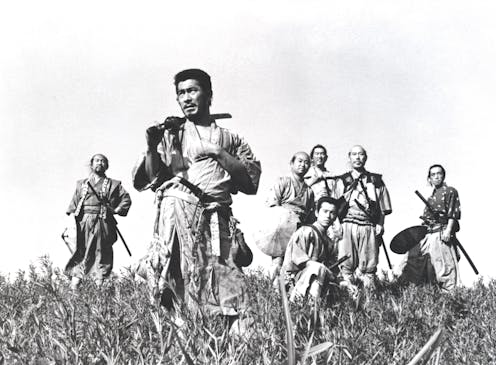Seven Samurai at 70: the greatest action film of all time
- Written by Stephen Gaunson, Associate Professor in Cinema Studies, RMIT University

Directed by Akira Kurosawa and starring Toshiro Mifune and Takashi Shimura, 1954’s Seven Samurai (七人の侍, Shichinin no Samurai), is a technical and creative watershed of the action genre and world cinema.
In 2021, Time Out magazine placed it at number three on its list of the best action movies of all time. The film was also named the greatest foreign-language film ever in BBC’s 2018 poll, which surveyed 209 critics across 43 countries.
Set in 16th-century feudal Japan, Seven Samurai follows a beleaguered village that hires seven warriors to defend against marauding bandits. It culminates in one of the greatest and most lengthy action sequences ever put to screen.
Beyond just the magnificence of the film itself – which has undergone an extensive restoration and will have a cinema re-release this month – is Kurosawas’s meticulous approach to the production.
Meticulous production
Before Seven Samurai, Kurosawa had risen to international prominence through his film Rashomon (羅生門) (1950), winning the prestigious Golden Lion at the 1951 Venice Film Festival.
Following its success he became more ambitious with his film choices.
Next came an adaptation of Fyodor Dostoevsky’s 1869 novel The Idiot (白痴) (1951), and Ikiru (生きる) (1952), a loose adaptation of Leo Tolstoy’s 1886 novella The Death of Ivan Ilyich.
For Seven Samurai, his following film, he went to new lengths with his preparation.
For every speaking character, Kuroswara wrote an individual dossier including specific details about clothes, foods, family history and other personal details. Directors such as Michael Mann and Quentin Tarantino have since incorporated this approach to their own productions, citing Kurosawa as their influence.
Part of the film’s appeal is how Kurosawa brings a breadth of vision to the past without dismissing deeper aspects of the farming community he depicts. Within this samurai epic are memorable and poignant moments of comedy, domestic drama and tragedy among the training of the farmers into effective samurai swordsmen.
Kurosawa’s idea for the story was pulled from historical annals, and the film was preceded by a lengthy period of historical research.
He had wanted to make a samurai epic for several years, but was unable to find material he felt would sustain a feature film. Producer Sôjirô Motoki discovered samurai in the “Warring States” period of Japan would volunteer to stand guard at peasant villages in exchange for food and lodging.
Kurosawa liked the idea and felt having local farmers trained as samurai to fight for their own land spoke profoundly to postwar Japan.
A new approach to filmmkaing
In Australia, Seven Samurai initially played at the 1956 Melbourne International Film Festival and wowed audiences in ways it has continued to wow new audiences throughout the past 70 years.
One enthusiastic Kurosawa fan was Australian director George Miller. There had always been a lot of Seven Samurai in the Mad Max movies. Compare the sparse dialogue, the restless camera movements, the invasive close-ups and natural sounds overlapped with the baroque soundtrack.
Mad Max: Fury Road is a more straightforward rethinking of Seven Samurai with the plot itself sharing a clear overlap of villagers required to learn the skills to fight off lawless rogues for their land.
This was the first film in which Kurosawa used multiple cameras, so he could shoot from different angles and directions without stopping the actors every time he wanted a different shot. Kurosawa would subsequently use a multiple-camera setup on every one of his following films.
Longer lenses (most notably the telephoto lens) were used in an unprecedented way with the camera photographing great detail, such as facial expressions and horses’ hooves through the teeming rain and mud splatter.
The epic action sequence to conclude the film is simply masterful. No film since has matched its cinematic physicality on a kinetic level. In Seven Samurai, Kurosawa demonstrated a new style of fight choreography that has never been surpassed.
Refusing to shoot the peasant village at Toho Studios, Kurosawa had a complete set constructed at Tagata on the Izu Peninsula, Shizuoka.
Because of the wet and sludge of the milieu, death is never glamorised or decorative. When they die, they die in the cold mud.
Focus on the individual
The great appeal of the film and why it arrived as a revelation was how Kurosawa presented an action film based on individuals rather than bureaucratic or political ambitions.
It is also worth considering how the film positions itself within postwar Japan as characters reassert themselves and their community without the support of the army.
Ultimately, this is a story about people in power helping those less fortunate. The final moments of the film reinstates this by demonstrating the survival of the farmers and farming community over lionising the individual heroes. People in power have a duty to help those less fortunate.
“The farmers have won. Not us,” the leader of the samurai group, Kambei Shimada (島田勘兵衛) (Takashi Shimura), declares to end the film.
It is hard to think of an action film that resonates so poignantly on an emotional and visceral level with audiences as Seven Samurai, even 70 years later. Its significance and legacy remain unparalleled.
Authors: Stephen Gaunson, Associate Professor in Cinema Studies, RMIT University
Read more https://theconversation.com/seven-samurai-at-70-the-greatest-action-film-of-all-time-234825





